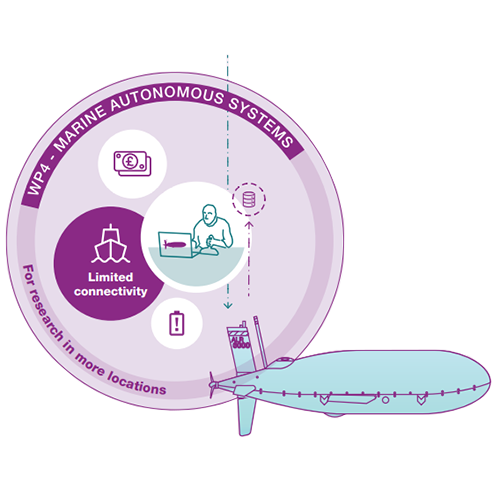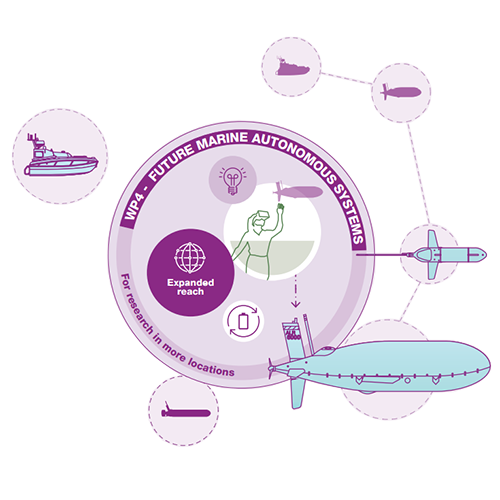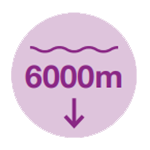WP4 Future marine autonomous systems
Key Findings
KF4.1

The marine autonomous systems market is developing rapidly. Over the last few years, there has been a significant increase in investment in the offshore energy, ocean science and defence sectors that has been driven by the need to reduce costs, improve data quality, and add new capabilities. These drivers are not expected to decrease, and so it is likely that the market will continue to grow and the technology development will continue to advance rapidly.
KF4.2
Persistent underwater autonomy is currently an active area of research, and recent work has been focusing on extending autonomous operations from days to weeks. The main obstacle to long-term missions is dealing with the uncertainty of an ever-changing environment. Marine robots need to deal with high variability across large-scale spatiotemporal dimensions while reacting to a locally dynamic and uncertain environment.
KF4.3
There is a growing trend where multiple platforms are working together as a system of systems to enable more complex data gathering. These ‘swarms’ can be a homogeneous set of vehicles all acting together to form a measurement network, an example being autonomous ocean bottom seismometers. Alternatively, the vehicles can create a heterogeneous ‘fleet’ where different vehicles undertake different functions. Fleets allow for parallelisation of missions, intervehicle support for longer deployment times, adaptability to in situ mission changes, and effective use of vehicles based on their specificities.
KF4.4
Another area of intense research has been risk-aware planning. Operations of AUVs in coastal regions, as opposed to deep water, expose AUVs to the risk of collision with ships and land.
KF4.5
The use of ocean gliders has steadily increased within the academic and defence sectors since the early 2000s. Their relatively low cost means they are often operated by science teams focused on ocean physics and are becoming an integral part of the Global Ocean Observing System (GOOS). Alongside the under-ice developments, gliders are continuing to be developed (e.g. Teledyne Webbs recent Slocum G3 release) and refined with the addition of new sensors (e.g. the RBR Legato CTD) and operating capabilities (e.g., Teledyne rechargeable batteries). One area of development is the push to increase the glider depth rating to 6000m, however, the limited commercial interest in deep rated gliders has meant that there are currently no commercially available systems.
KF4.6
Complementing glider operations are the new long-range AUVs. These platforms offer a similar range to gliders but can carry increased sensor payloads at higher speeds. Thus, they have a more comprehensive range of applications from Ocean Physics, through nutrient and carbonate system measurements, to seafloor mapping (either optically or acoustically).
KF4.7
Alongside the sampling issues, MAS platforms cannot currently launch and recover fixed platforms to the seabed, something that is relatively easy from a crewed ship. The most significant limitation is the deployment and recovery of moorings. Alongside moorings, MAS platforms cannot easily launch and recover landers or other bespoke seabed experiments. Thus, moving to a purely MAS based solution would significantly hamper the opportunity to deploy these sorts of experiments.
Key Recommendations

KR4.1
The “brains” of marine robots are critical to their ability to undertake more complex behaviours and thereby increase their capabilities. Hence, the NOC-developed Onboard-Control-System (OCS) and shore side Command and Control (C2) systems will need to be further developed. Specific areas of development include the Automated Piloting Framework (APF) of the C2, which allows machine-based control of the long-range fleet. The C2 will be further extended with integration of new platforms, development of a PI portal, creation of fleet planning tools and refinements of data flows.
KR4.2
New autonomy behaviours will also need to be developed within the OCS to support safe under-ice operations. The OCS will be further extended with integration of new sensors, refinement of the backseat driver interface, and integration into new platform types.
KR4.3
There is a need to operate near boundaries and on the seafloor, so work should be undertaken to further develop hover capable and crawling vehicles. These additions to the fleet would increase the range of science missions that marine robots can undertake and hence increase their use in observing the ocean.
KR4.4
Launch and recovery systems from Unmanned surface vehicles (USVs) (for gliders and autonomous underwater vehicles (AUVs)) should be developed at pace for greater flexibility in the use of MAS platforms to support oceanographic research by increasing endurance and data transfer options.
KR4.5
Marine battery/fuel cell technology will underpin much of the expansion in use of MAS platforms and should be a priority for UKRI/NERC (InnovateUK) working in tandem with industry.
KR4.6
NERC should expect to double the size of the autonomous fleet it supports every 5 years. A total fleet comprising over 200 gliders, 25 long-range AUVs, 2 short-range AUVs and the associated USVs as well as smaller AUVs deployable by hand should be available within the NMPE by 2035.
KR4.7
Remotely operable ROVs should be introduced into the NMEP to remove personnel required onboard vessels and to increase their availability. This is possible with increased bandwidth on vessels.
KR4.8
Research into sustainable solutions to overcome marine biofouling should be funded.


